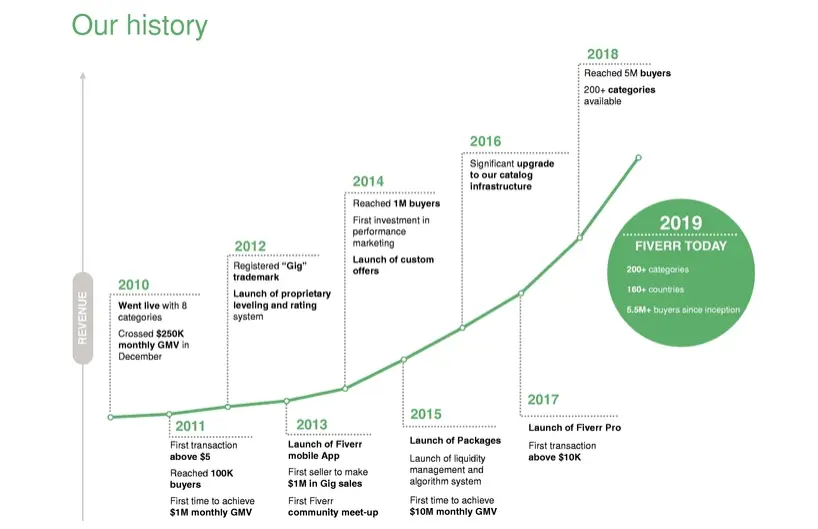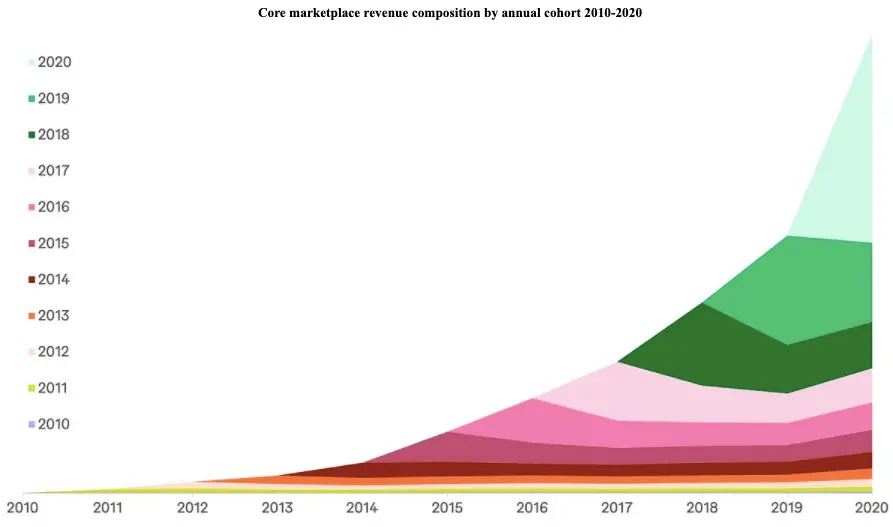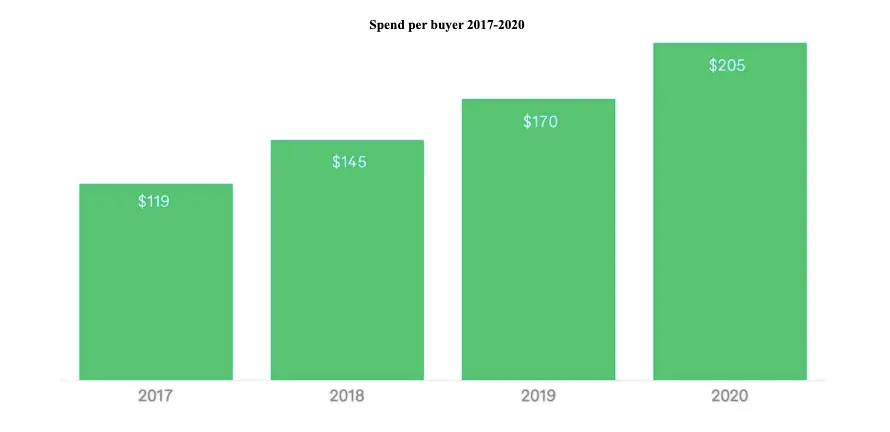The expected value of the global gig economy, which is a term used to classify independent contractors/freelancers, is projected to be $455 Billion by 2023.
In 2018, the global gig economy generated $204B in Gross Volume — with transportation-based services comprising 58% of the value, the asset-sharing sector capturing 30% & the remaining 12% being distributed among professional services & HGIM (Handmade Goods, Household & Miscellaneous Services)
Fiverr, which falls under the professional services category of the gig economy, is a two-sided digital marketplace that connects people who are interested in doing gig work (sellers) to people who want to get gig work done (buyers).
Started by two entrepreneurs, Micha Kaufman and Shai Wininger in 2010, Fiverr launched with support for only 8 service categories but has come a long way since then, generating $189.51 million in revenue in 2020, almost double the $107.1 million revenue in 2019.

Source: Fiverr SEC filing
The company was started with a simple idea: people should be able to buy and sell digital services in the same fashion as physical goods on an e-commerce platform.
Having experienced firsthand how challenging the process of working with freelancers can be, the founders developed Fiverr’s digital marketplace to mirror the typical e-commerce transaction, having a comprehensive SKU-like services catalog and an efficient search, find, and order process.
Before we get into how Fiverr makes money, how much revenue it generates & what metrics it uses to track its business, let’s look into Fiverr’s value proposition for Buyers & Sellers, to develop a better understanding of the business.
Value Proposition For Buyers
— With sophisticated browsing and filtering functions to navigate their catalog of digital services, Fiverr reduces the friction and inefficiencies in the process of hiring a gig worker, thus saving valuable time for buyers.
— In 2020, Fiverr reported that its expansive digital catalog of services had over 500 categories, with gig prices ranging from $5 to thousands of dollars.
— Instant access to thousands of freelancers having a broad set of skills
— For buyers, Fiverr enables certainty of price, the scope of work, and quality.
— To make sure they get repeat purchases from buyers, Fiverr prioritizes dispute resolution
Active Buyers on Fiverr
In the year 2020, Fiverr had 3.4 million active buyers, up 41.6% from the 2.4 million active buyers in 2019
Value Proposition to Sellers
— Fiverr matches sellers with buyers directly without sellers having to bid on projects, enabling sellers to focus on providing services.
— Freelancers can work remotely, from wherever they want & whenever they want.
— Fiverr works with third-party agents to collect money from buyers at the time of purchase & releases the funds to sellers at the time of project completion, making the process of receiving payments frictionless.
— Sellers can create a personal storefront ( seller page ) to showcase their services to buyers.
— Fiverr provides sellers with tools to manage the administrative aspects of their business.
— Sellers are provided with 24/7 platform support in their freelance journey.
Active Sellers on Fiverr
In the 12 months prior to March 31, 2019, Fiverr had approximately 255,000 active sellers from over 160 countries across the globe.
Fiverr Business Model
Fiverr makes money from the commission it levies upon buyers & sellers following the classic marketplace model. When buyers place an order, Fiverr charges them a 5% service fee apart from the Gig price. Once the gig is completed successfully, Fiverr pays 80% of the gig price to the seller, reserving a 20% cut for itself.
As I mentioned earlier, Fiverr’s revenue grew from $107.1 million in 2019 to $189.5 million in 2020. During the same period, losses reduced from $33.5 million in 2019 to $14.8 million in 2020.

Fiverr’s revenue growth was primarily driven by repeat buyers whose collective spending on the platform keeps growing. As repeat buyers use Fiverr, placing more orders and ordering higher value and cross-category services, the lifetime value of the repeat buyer cohort also keeps growing. These inherently favourable dynamics of Fiverr’s business also provide revenue visibility and predictability.
Fiverr’s take rate, the commission from buyers and sellers combined, was 27.1% and 26.7% in 2020 and 2019 respectively. Fiverr generates revenue from a broad mix of digital services spanning over 500 categories across eight verticals, including Graphics & Design, Digital Marketing, Writing & Translation, Video & Animation, Music & Audio, Programming & Tech, Business, and Lifestyle. None of the calories contribute more than 15% of Fiverr’s marketplace revenue, meaning revenue is diversified across categories.
Geographically, most of Fiverr’s revenue comes from buyers in English-speaking countries. In 2020 and 2019, close to 70% of the marketplace revenue was generated from Gigs purchased by buyers located in the United States, United Kingdom, Canada, Australia, & New Zealand. As Fiverr expands to include additional languages and deepen its penetration in Western Europe, the Asia Pacific & Latin America, the geographic mix of revenue could change with time.
As Fiverr grows, the network effect of the platform gets stronger. More buyers attract more sellers, leading to improved selection and better value for money, further enhancing engagement and increasing spending by buyers.
Historically, Fiverr has experienced strong revenue consistency from its annual buyer cohort. As is evident from the image below, the aggregate spend of every cohort stabilizes after the first year, continually contributing a steady revenue stream in future years through repeat buying.

How Fiverr Evaluates the Strength of its Business
Every company has what’s called a north star metric — which is used to measure the success of its business. While each and every internal department might have a different north star metric, the company-wide north metric is what all departments cumulatively work to push forwards.
In the case of Fiverr, the company measures two north star metrics to judge its success: repeat buyers & spend per buyer.
The reason Fiverr focusses on repeat buyers is because it generated the majority of its revenue from repeat buyers & repeat buyers are even more likely to recommend Fiverr. Repeat buyers contributed to 55% & 58% of Fiverr’s revenue in 2020 and 2019 respectively. As Fiverr gains more repeat buyers, the amount each buyer spends also goes up.

As you can see in the image, spend per buyer close to doubled from $119 in 2017 to $205 in 2020. However, despite Fiverr’s north metrics headed in a positive direction, the company is yet to make a profit.
Fiverr Acquisitions
Fiverr acquired Video creation marketplace VeedMe & Content marketing platform ClearVoice to bolster valuable individual categories like video production & content marketing.
In Jan 2018, Fiverr also acquired AND CO, a software for freelancers looking to manage their client relationships.
In August 2020, Fiverr acquired SLT consulting, a digital marketing agency that built its business using Fiverr. In 2021, Fiverr acquired the creative talent marketplace Working Not Working.
Read More Case Studies
Netflix Business Model Case Study
Pinterest Business Model Case Study
Grammarly Business Model Case Study

